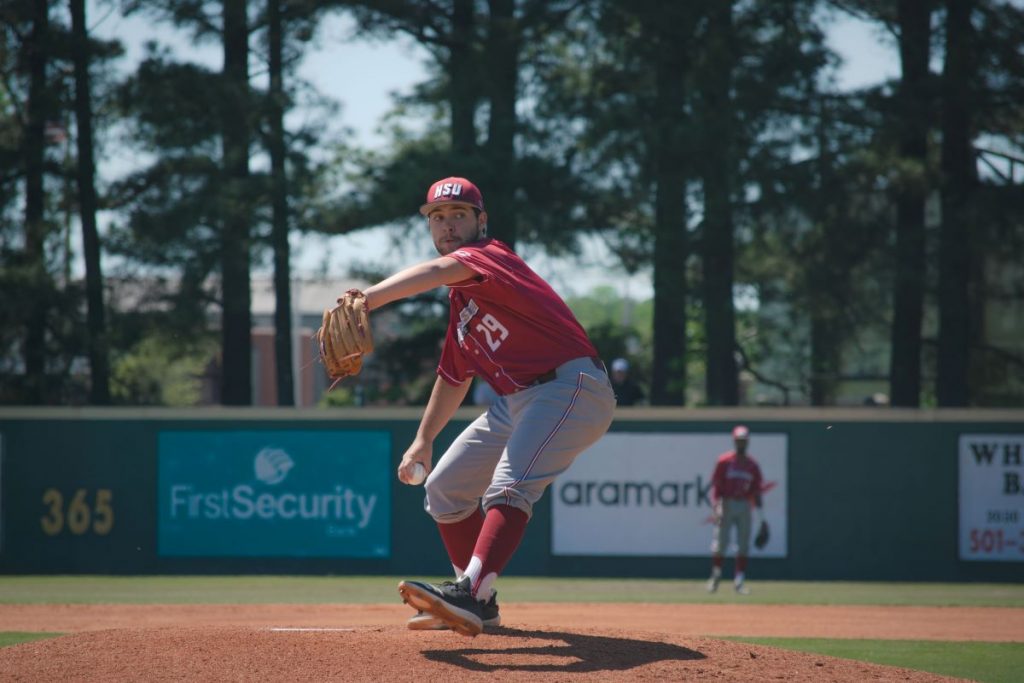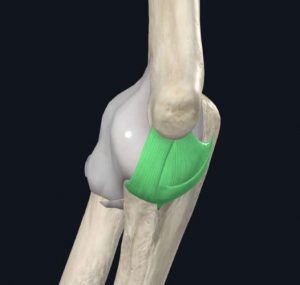
If you’re a fan of baseball, you have probably heard of Tommy John surgery, named after the famous baseball pitcher who first underwent the procedure in 1974.
Tommy John surgery involves reconstruction of the Ulnar Collateral Ligament (UCL) and is common in younger overhead athletes (especially pitchers), javelin throwers, and sometimes racquet sport athletes or hockey players.
The good news is UCL injuries in younger athletes less frequently involve surgical intervention and have shown good response to conservative management including physical therapy to return the athlete to sport.
Let’s take a look at the role of the UCL to better understand the injury, surgical repair or reconstruction, and the overall rehab process.
The UCL
The UCL is a ligament, which is a piece of fibrous connective tissue that connects bone to bone. In this case, the UCL, connects the upper arm bone (humerus) to the largest forearm bone (ulna).
- The UCL, located on the pinky side of the elbow
This ligament plays an important role in providing stability to the inner elbow, especially when the elbow is bent. According to research, when the elbow is bent to 90 degrees, the UCL provides ~50% of the stability at the elbow. This is the same position that overhead throwers and hitters adopt repetitively, which is why these sports typically result in UCL injuries.
The UCL prevents separation of the inner elbow when force is placed from the inside to outside of the elbow joint in the late cocking and acceleration phase of pitching.
The UCL is a good stabilizer, but not alone. It needs the help of surrounding and neighboring muscles, like the:
- Wrist flexors, which attach to the inside of the elbow and bend your wrist forward
- Pronators, which also attach to the inside of the elbow and rotate your forearm so your palm faces down
- Rotator cuff, or the group of muscles that provide shoulder stability
If these muscles are weak or are not coordinating well, the UCL works overtime to stabilize the elbow, especially during throwing activities. When you’re repetitively stressing the ligament, it’ll be vulnerable to injury.
What to Expect After a UCL Injury
Typical signs and symptoms of an injury to the UCL include:
- Pinpoint tenderness at the inner elbow or pain during or after throwing or use
- Stiffness of the elbow, especially being unable to fully straighten the arm
- Hearing a pop at the elbow followed by pain
- Possible numbness or tingling in the 4th or 5th digit (due to stress of the ulnar nerve)
If you have any of these signs or symptoms, follow up with your primary care physician who may further refer you to an orthopedic specialist. Your doctor will be able to determine through a physical examination if your symptoms warrant any further testing, like an x-ray or MRI. An MRI is best to examine the damage to the UCL directly, but your doctor may also order an x-ray to ensure there’s no bony damage.
Follow-up treatment will depend upon the grade of the UCL sprain:
- Grade I: Involves no tear, but the ligament is stretched.
- Grade II: The ligament is stretched and usually partially torn.
- Grade III: The ligament is completely torn.
The vast majority of grade I-II tears respond well to conservative management, which includes physical therapy. Most throwing athletes can return to play in three to four months through a throwing program, which progresses the player carefully under the supervision of a rehab or athletic professional.
In conjunction with physical therapy, some studies have also recommended platelet-rich plasma (PRP) injections to accelerate tissue healing and have shown good results. Talk to your doctor about whether PRP injections are right for you.
If a grade I or II tear fails conservative management, or if the UCL is completely torn, UCL reconstruction surgery (Tommy John surgery) is still the gold standard for operative management.
This surgery can be performed with multiple graft types, but the most common is the palmaris longus tendon of the forearm because of its proximity to the surgical site. Sometimes doctors elect to use the calf tendon, hamstring tendon, or toe extensor tendon instead, depending on your circumstance. You can ask your surgeon about his approach.
Studies show good RTP percentages of ~92-93% after surgery with expected time to full RTP anywhere from 12-15 months, depending upon the rehabilitative protocol outlined by the surgeon. These percentages apply to youth athletes, collegiate players, and professional athletes.
Revision rates for UCL reconstruction are low with proper rehabilitation, which is great news for our patients!
Physical Therapy for a UCL Sprain
If you are a thrower and have suffered a UCL sprain without surgery, your first physical therapy visit will consist of an individualized assessment to determine areas of concern that may affect your ability to stabilize your elbow while throwing.
Your therapist will examine the range of motion, strength, and ligamentous stability at your elbow, but other areas of your body also contribute to your throwing ability, like your shoulder and trunk.
For example, to reduce any stress to the UCL at the elbow while throwing, you will need at least 180 degrees of shoulder rotation range of motion. This is one of the first things physical therapists examine with throwing athletes.
Here are two stretches that can be performed in order to improve your shoulder rotation, range of motion, and mobility.
90/90 External Rotation Dowel Stretch
- Start by lying on your back with your shoulder supported by the bed/table and your arm hanging off.
- Use a dowel, umbrella, or cane to push your arm into rotation backwards with the opposite hand into a goal post position.
- You should feel a stretch in the front of your shoulder. Be sure the stretch is pain-free!
- Hold the stretch for 30 seconds and perform at least 3 repetitions.
Sleeper Stretch for Internal Rotation
- Start by lying on your side, but be sure to roll slightly off your shoulder. Place your elbow in line with your shoulder and bend your elbow to 90 degrees. Use your opposite hand while gripping at the wrist to push your arm down into rotation forwards.
- Be sure to maintain the proper position of your shoulder in contact with the bed/floor/table and your elbow and wrist by keeping the joints in a straight line. e. You should feel a stretch in the back of your shoulder.
- Hold for 30 seconds and perform at least 3 repetitions.
Once you have full shoulder range of motion, the next step is to improve shoulder and scapular strength, stability, and control.
Your physical therapist will prescribe targeted exercises based on the findings of your initial evaluation to address areas of concern while slowly progressing you to a return-to-throw program.
A good resource for shoulder, back, and elbow strengthening for throwers is the Thrower’s Ten program (PDF) developed by Kevin Wilk, DPT and Dr. James Andrew. Using data from EMG studies performed at the American Sports Medicine Institute (ASMI), these individuals were able to develop a rehab program that targets the muscle groups required to perform and maintain proper throwing mechanics. Be sure to perform these exercises only under the supervision and guidance of a rehab professional, especially if you are injured.
Physical Therapy after UCL Reconstruction
Physical therapy after UCL reconstruction differs from a UCL sprain in that your elbow range of motion and loading of the arm will be limited by your surgeon’s protocol.
After surgery, you may be placed in an arm splint that keeps the elbow in a 90-degree bend with the forearm in a neutral position.
Over the course of the next several weeks, you’ll gradually stretch the elbow and load the arm under the supervision of your physical therapist.
Once your surgeon lifts the range of motion and weight-lifting precautions, your rehab will look pretty similar to the process described above for a UCL sprain.
Remember, return to play can take up to 12–15 months, so be patient!
Reach out
If you or someone you know is looking for physical therapy services after surgery or injury, look no further! Please call (808) 381-8947 to schedule an initial evaluation with JACO rehab today.
Written by Jenn Lewis, DPT
